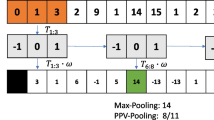Abstract
The forecasting of time series data is an integral component for management, planning, and decision making. Following the Big Data trend, large amounts of time series data are available in many application domains. The highly dynamic and often noisy character of these domains in combination with the logistic problems of collecting data from a large number of data sources imposes new requirements on the forecast process. A constantly increasing number of time series has to be forecast over several periods in order to enable long-term planning with high accuracy and short execution time. This is almost impossible, when keeping the traditional focus on creating one forecast model for each individual time series. In addition, often used forecast techniques like ARIMA require complete historical data and fail if time series are intermittent. A method that addresses all these new requirements is the cross-sectional forecasting approach. It utilizes available data from many time series of the same domain in one single model; thus, missing values can be compensated and accurate forecast results are calculated quickly. However, this approach is limited by a rigid data selection and existing forecast methods show that adaptability of the model to the data increases the forecast accuracy. Therefore in this paper, we present CSAR, a model that extends the cross-sectional paradigm by adding more flexibility and allows fine-grained adaptations toward the analyzed data. In this way, we achieve an increased forecast accuracy and thus a wider applicability.








Similar content being viewed by others
References
Aldrin, M., Damsleth, E.: Forecasting non-seasonal time series with missing observations. J. Forecast. 8(2), 97–116 (1989). https://doi.org/10.1002/for.3980080204
Bemdt, D.J., Clifford, J.: Using dynamic time warping to find patterns in time series. In: AAAIWS’94 Proceedings of the 3rd International Conference on Knowledge Discovery and Data Mining, pp. 359–370 (1994)
Box, G.E.P., Jenkins, G.M., Reinsel, G.C.: Time Series Analysis: Forecasting and Control (Wiley Series in Probability and Statistics). Wiley, New York (2008)
Chatfield, C.: Time-Series Forecasting. Chapman & Hall/CRC Press, Boca Raton (2000)
Croston, J.D.: Forecasting and stock control for intermittent demands. Oper. Res. Q. 23(3), 289–303 (1972). https://doi.org/10.2307/3007885
Fliedner, G.: Hierarchical forecasting: issues and use guidelines. Ind. Manag. Data Syst. 101(1), 5–12 (2001). https://doi.org/10.1108/02635570110365952
Friedman, J.H.: Multivariate adaptive regression splines. Ann. Stat. 19(1), 1–67 (1991). https://doi.org/10.1214/aos/1176347963
Friedman, J.H.: Greedy function approximation: a gradient boosting machine. Ann. Stat. 29(5), 1189–1232 (2001)
GOFLEX Project. http://goflex-project.eu/ (11.02.2017)
Hartmann, C., Hahmann, M., Habich, D., Lehner, W.: CSAR: The Cross-sectional autoregression model. In: 2017 International Conference on Data Science and Advanced Analytics (DSAA 2017), Tokyo, pp. 1–10 (2017)
Hartmann, C., Hahmann, M., Rosenthal, F., Lehner, W.: Exploiting big data in time series forecasting : a cross-sectional approach. In: IEEE International Conference on Data Science and Advanced Analytics (DSAA), 2015, Paris, pp. 1–10 (2015). https://doi.org/10.1109/DSAA.2015.7344786
Holt, C.C.: Forecasting seasonals and trends by exponentially weighted moving averages. Int. J. Forecast. 20(1), 5–10 (2004). https://doi.org/10.1016/j.ijforecast.2003.09.015
Hyndman, R.J., Khandakar, Y.: Automatic time series for forecasting: the forecast package for R. J. Stat. Softw. 27(3), 1–22 (2008)
IJCAI: IJCAI 2017 - Data Mining Contest (08.02.2017). http://tb.am/s0a3o
Irish Social Science Data Archive (ISSDA): CER Smart Metering Project. The Commission for Energy Regulation (CER) (28.04.2015). www.ucd.ie/issda
Levy, D.: Introduction to Numerical Analysis (2010)
McCarthy, T.M., Davis, D.F., Golicic, S.L., Mentzer, J.T.: The evolution of sales forecasting management: a 20-year longitudinal study of forecasting practices. J. Forecast. 25(5), 303–324 (2006). https://doi.org/10.1002/for.989
Neupane, B., Pedersen, T.B., Thiesson, B.: Towards flexibility detection in device-level energy consumption. In: Woon, W.L., Aung, Z., Madnick, S. (eds.) Data Analytics for Renewable Energy Integration: Proceedings of the Second ECML PKDD Workshop, DARE 2014, vol. 8817, Nancy, pp. 1–16 (2014). https://doi.org/10.1007/978-3-319-13290-7_1
R Core Team: R: A Language and Environment for Statistical Computing. R Foundation for Statistical Computing, Vienna, Austria (2014). http://www.R-project.org/
Riise, T., Tjostheim, D.: Theory and practice of multivariate arma forecasting. J. Forecast. 3(3), 309–317 (1984). https://doi.org/10.1002/for.3980030308
Robert, N.: Statistical forecasting: notes on regression and time series analysis. http://people.duke.edu/~rnau/411home.htm. Accessed 09.11.2016
Shenstone, L., Hyndman, R.J.: Stochastic models underlying Croston’s method for intermittent demand forecasting. J. Forecast. 24(6), 389–402 (2005)
Tiao, G.C., Box, G.E.P.: Modeling multiple time series with applications. J. Am. Stat. Assoc. 76(376), 802–816 (1981). https://doi.org/10.1080/01621459.1981.10477728
Universal Smart Energy Framework (USEF). www.usef.energy (11.02.2017)
VDE Verband der Elektrotechnik Elektronik Informationstechnik e.V.: Messwesen Strom (Metering Code); VDE-AR-N 4400 (2011)
Vermesan, O., Friess, P.: Internet of Things: Converging Technologies for Smart Environments and Integrated Ecosystems. River Publishers, Aalborg (2013)
Author information
Authors and Affiliations
Corresponding author
Additional information
Publisher's Note
Springer Nature remains neutral with regard to jurisdictional claims in published maps and institutional affiliations.
This paper is an extension version of the DSAA’2017 Research Track paper titled “CSAR: The Cross-sectional Autoregression Model” [10]
This work is partly funded (1) by the German Research Foundation (DFG) in the context of the project Flash-Forward Query Framework” (LE-1416/17-2), (2) by the European Regional Development Fund (ERDF) under co-financing by the Free State of Saxony (100320127) and Systema GmbH, and (3) within the DFG CRC 912 (HAEC).
Rights and permissions
About this article
Cite this article
Hartmann, C., Ressel, F., Hahmann, M. et al. CSAR: the cross-sectional autoregression model for short and long-range forecasting. Int J Data Sci Anal 8, 165–181 (2019). https://doi.org/10.1007/s41060-018-00169-7
Received:
Accepted:
Published:
Issue Date:
DOI: https://doi.org/10.1007/s41060-018-00169-7




